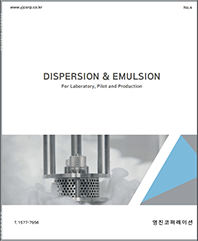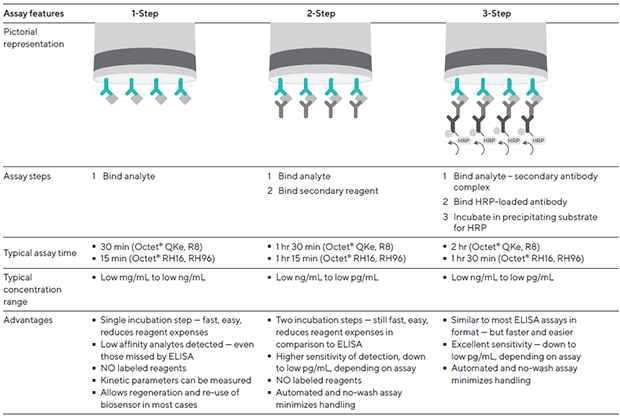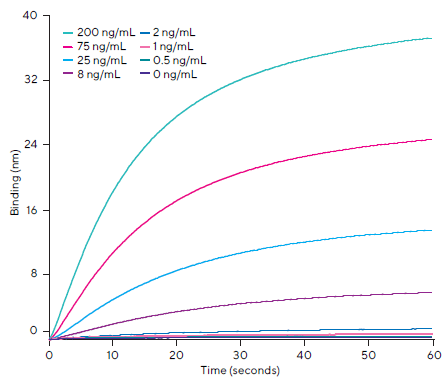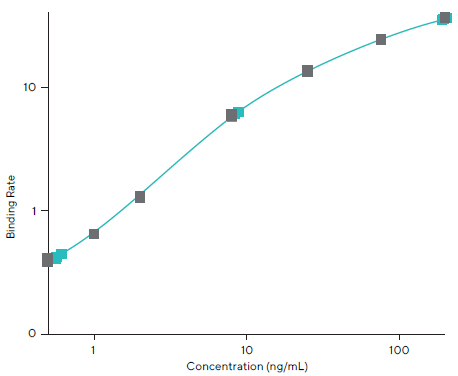| Phone |
| |
| |
| 대표전화 |
1577-7956 |
| 본 사 |
031-457-9187 |
| 대 전 |
042-932-1265 |
| |
|
| Web Site Visitors |
| |
| |
| Today |
1098 |
| Yesterday |
1750 |
| Since 2006 |
2,323,154 |
| |
|
 |
|
| 영진코퍼레이션 종합카다로그 |
|
|
| ■ |
Converting an ELISA Assay into an Octet® Quantitation Assay |
|
| | 원본보기 | 리스트돌아가기 | |
Abstract
Enzyme-linked immunosorbent assays (ELISA) 는 분자를 정량화 하는데 널리 사용되고 있습니다.
선호도가 높은 실험법임에도 불구하고 많은 시간과 노동력을 필요로 합니다.
Octet® 플랫폼을 이용한 정량 검사는 자동화된 ELISA 의 형태로 보일 수 있지만 일반적인 ELISA 에 비해 수 많은 이점을 가지고 있습니다.
특히, 분자간 친화력이 낮을 때도 상호 작용을 감지할 수 있고 실험자가 직접 실험 하는 시간을 줄여줍니다.
기존의 ELISA 를 Octet® 분석법으로 변환하여 실험하기 위해서는 조건 (condition) 과 구성 (configuration) 을 다시 최적화 (re-optimization) 하고
이에 대한 검증(validation) 이 필요합니다.
이 어플리케이션 노트에서는 분석에 필요한 요구 사항들을 정의하고 바이오센서의 유형 및 분석 형식의 선택, 비특이적 결합의 최소화, 분석 완충액 최적화를 포함하여
ELISA 기반 분석을 Octet® 으로 변환하기 위한 주요 단계들을 설명하고 소개하고자 합니다.
Introduction
Octet® 플랫폼의 정량 분석은 ELISA 와 많은 유사점을 가지고 있습니다.
둘 다 분석물과 결합 하는 분자가 고정되어 있고 분석물은 용액에 있는 상태에서 분자와 분석물이 결합하는 방식을 이용합니다.
시험을 통해 확인한 결과는 결합된 분석물의 양에 직접 또는 반비례합니다. 그렇기에, Octet® 의 정량 분석은 ELISA 의 자동화된 형태로 보여질 수 있습니다.
Octet® 을 이용한 분석은 기존의 ELISA 의 조건과 구성을 다시 최적화 하고 검증하는 것을 포함하고 있습니다.
하지만, 최소 필수 요구 사항이 엄격한 경우 추가적인 개발 작업이 필요합니다.
Octet® 플랫폼을 이용한 분석은 ELISA 분석법 보다 연구자에게 더 나은 이점을 제공합니다.
| 1. |
Choose from a number of assay formats (label-free direct binding, sandwich, sandwich followed by signal amplification, etc.) to suit detection limit requirements |
| 2. |
Detect low-affinity analytes s often missed by ELISA |
| 3. |
Minimize handing via automated and wash-free steps |
| 4. |
Fully recover and re-use samples and reagents |
| 5. |
Regenerate the assay surface and re-use for some binding pairs (e.g., Protein A/human IgG) |
이 어플리케이션 노트에서는 기존의 ELISA 분석을 Octet® 으로 변환하여 실험할 때 고려해야 하는것과 방법을 제공합니다. 이 과정은 5단계로 나눌 수 있습니다.
| 1. |
Defining assay requirements |
| 2. |
Selecting a biosensor type |
| 3. |
Selecting assay format |
| 4. |
Minimize non-specific binding (NSB) |
| 5. |
Optimizing assay buffer |
각 단계에 대한 자세한 내용은 해당 섹션에 나와 있습니다.
Defining Assay Requirements
ELISA 에서 Octet® 으로 변환은 실험의 조건을 정의하는 것부터 시작해야 합니다.
샘플의 감도와 요구 처리량은 Octet® 기기와 바이오센서 유형 및 분석 형식을 결정하는데 중요한 요소가 되고 샘플의 구성은 사용 할 시약의 제형과 blocking 과정에 가장 큰 영향을 미칩니다.
샘플의 용량도 기기 선택에 영향을 미칩니다. Octet QKe, RED 및 R8은 80 ~ 200 μL 의 샘플이 필요하고, Octet® RH16 및 RH96 에는 40 ~ 80 μL 의 샘플이 필요합니다.
또한, 샘플의 용량이 제한적인 경우 샘플을 희석하여 실험을 진행할 때 검출 감도에 간접적으로 영향을 미칩니다.
표면과 고정화 프로토콜을 선택할 때 분석물의 물리적 특성 (pl, size, polymeric status, hydrophobicity, stability, etc.) 을 고려하여야 합니다.
Selecting a Biosensor Type
Octet® 플랫폼에서 정량 분석을 수행할 때 고려해야 할 바이오센서는 4가지 종류가 있습니다.
Streptavidin(SA), Aminopropylsilane(APS), Amine-Reactive(AR) 그리고 분석물 특정 바이오센서입니다.
SA, APS, AR 바이오센서는 특정 공정에 맞는 분석 항목에 대한 맞춤형 정량 분석법을 구축하는데 사용할 수 있습니다.
Streptavidin 바이오센서는 streptavidin/biotin 상호작용을 통해 다양한 ligand 를 수용할 수 있는 유연성과 특별히 설계된 cross-linked streptavidin 접합체를 사용하여 얻은
뛰어난 표면 용량으로 가장 선호 되는 바이오센서 입니다. 낮은 몰 결합 비율에서 long-chain biotin 으로 표지 된 ligand 를 고정하는데 이점이 있습니다.
| 1. |
Loss of binding capacity due to cross-linking and steric hindrance are reduced. |
| 2. |
Biosensor can be prepared in batch mode and stored for later use. |
| 3. |
The biotin-ligand solution may be used to prepare multiple batches of biosensors. |
| 4. |
The strong, nearly irreversible binding between the biotinylated ligand and the Streptavidin Biosensor allow easy regeneration of the ligand-loaded biosensor. |
Aminopropylsilane(APS) 바이오센서는 공유 결합에 적합하지 않은 ligand 를 고정하는데 이상적입니다.
소수성 및/또는 정전기적 상호작용으로 ligand 를 고정합니다.
APS 바이오센서 표면은 ELISA microplate 의 표면과 비교했을 때 소수성이 강하기 때문에, 변성을 방지하기 위해 바이오센서 표면에서 ligand의 안정성을 우선 테스트해야 합니다.
Amine-Reactive(AR) 바이오센서는 바이오센서의 carboxylate 그룹에 amine 그룹이 포함된 ligand를 공유적으로 고정하는데 사용할 수 있습니다.
배치 모드 제작과 바이오센서 재생이 가능합니다.
분석물 특정 바이오센서는 anti-human IgG, anti-mouse IgG(Fab’)2, Protein A, Protein G, anti-penta HIS 와 같은 특정 포획 단백질로 미리 고정됩니다.
분석물 특정 바이오센서는 human IgG, mouse IgG(Fab’)2, Protein A, Protein G 에 결합하는 단백질, penta-HIS 태그가 달린 단백질의 정량 분석에 적합합니다.
Selecting Assay Format
Octet® 을 이용한 시험법의 선택은 정량화 할 분석 대상의 농도 범위에 따라 달라집니다.
Octet® 은 직접 결합 분석법 (1단계 분석법) 의 이점을 제공하며, 일반적으로 분석물에 따라 낮은 ng/mL 에서 낮은 mg/mL 까지 동적 검출 범위를 제공합니다.
직접 결합 분석법은 빠르고 간편하며 2차 시약과 단계가 필요 없습니다. 또한, 어떤 경우에는 바이오센서를 재사용 할 수도 있습니다.
다단계 분석은 분석물에 따라 낮은 pg/mL 까지 향상된 측정을 가능하게 합니다.
Octet® 은 분석물 결합층의 두께와 밀도의 함수로 신호를 측정함으로 분석물 결합을 증가시키면 더 큰 신호를 얻을 수 있습니다.
분석물이 낮은 농도로 존재하고 오랜 배양 후에도 결합 신호가 낮으면 분석물 결합층 위에 2차 시약을 추가로 결합층을 형성하면 신호가 향상 됩니다.
이러한 다층 분석에는 샌드위치 스타일 분석법 (2단계 분석법) 이 있습니다.
샌드위치 스타일 분석법은 바이오센서를 사용하여 첫 번째 단계에서 분석물과 결합한 다음 두 번째 단계에 서 항체를 이용하여 분석물을 샌드위치 합니다.
신호를 더욱 증폭 시키기 위한 효소 연결 샌드위치 분석법 (3단계 분석법) 은 첫 번째 단계에서 두 개의 별도로 표지 된 포획 분자(capture molecules)가 바이오센서에 결합된 분석물에 결합하고,
두 번째 단계에서는 HRP-접합 항체를 1단계에서 형성된 복합체에 결합시키고, 세 번째 단계에서 기질을 바이오센서 표면에 직접 침전 시킵니다.

Table 1 : Octet® assay formats and features
Minimize Non-Specific Binding(NSB)
NSB 및 매트릭스 효과 (matrix effects) 를 관리하는 것은 허용 가능한 특이성과 민감성을 보장하는 분석 개발 과정의 중요한 부분입니다.
NSB 의 주요 원인은 바이오센서 표면과 용액 분자 간의 소수성, 정전기적 및 교차 반응성 상호 작용입니다.
NSB 외에도 관련 없는 단백질과 샘플 매트릭스 의 다른 구성 요소가 종종 분석 간섭을 일으킵니다.
이러한 효과를 최소화하는 가장 효과적인 방법은 샘플과 결합하기 전에 blocking 단계를 포함하여 바이오센서 표면에 보호막을 씌우는 것입니다.
Blocking 버퍼의 조성은 샘플 매트릭스 와 일치해야 합니다 (혈청 내 면역원성을 확인하기 위해 혈청으로 blocking).

Figure 1 : Raw data from the final amplification step of the CHO HCP assay using Octet® R8 system.

Figure 2 : Standard curve showing standards (n = 3 for each standard) and unknown samples (n = 8 for each unknown).
The lower limit of detection in this assay was less than 0.5 ng/mL.
Optimizing Assay Buffer
시험을 위한 버퍼의 조성은 NSB, 샘플 매트릭스 간섭 및 배경 신호에 상당한 영향을 미칩니다.
시약 제형을 최적화 하는 목표는 원하는 특정 신호를 최대화 하고 NSB를 최소화 하는 것입니다.
대부분의 경우에는 이전에 개발된 ELISA 버퍼를 직접 적용하여 사용해도 되지만, Sartorius 바이오센서와 호환되지 않는 구성이나 조건이 포함되어 있는 경우에는 예외로 하여야 합니다.
호환되지 않는 버퍼의 예로는 낮은 pH(<4), 높은 pH(>10) 및 특정 유형의 유기 용매가 있습니다.
분석 버퍼를 개발할 때는 분석 대상의 특성(pl, 소수성 및 안정성) 과 샘플 매트릭스 구성 요소를 염두에 두는 것이 중요합니다.
관련된 사항으로, Octet® 분석 과정 중 샘플 wash 단계에서는 계면활성제(detergent) 성분이 들어 있는 TBS나 PBS와 같은 버퍼를 사용합니다.

Table 2 : Accuracy and robustnss of CHO host cell protein quantitation.
In this assay, CVs of less than 10% were achievable across the entire dynamic range
다음은 시험법의 최적화를 위한 추천하는 일반적인 버퍼의 구성요소 목록입니다.
| 1. |
Salt: high salt concentrations slow down the reaction, reduce stickiness of antigens with very high/low pI values, reduce charge-induced NSB and
denature proteins in solution when needed (e.g., Protein A contamination assay sample pre-treatment buffer). |
| 2. |
Buffer capacity: higher buffer capacity minimizes pH changes and stabilizes sample solutions |
| 3. |
Non-specific antibodies: reduce NSB from multi-species cross-reactions. |
| 4. |
Detergents: reduce sample aggregation, reduce hydrophobic NSB and reduce sample coating out of very low concentration samples |
| 5. |
Bulk proteins (BSA, casein, antibodies): serve as blocking agents, reduce sample coating out of solution, and stabilize analyte proteins in solution in other ways. |
| 6. |
Sugars (trehalose, dextran, sucrose): stabilize some proteins, enhance signal by increasing effective concentration in solution. |
| 7. |
PEG : helps reduce non-specific binding and can enhance signal in some cases by increasing the effective concentration of proteins in solution. |
| 8. |
pH : low pH may often reduce the affinity of competing interactions and improves the proportion of ligandanalyte binding to the biosensor. |
| 9. |
Dilution : to minimize matrix effects. |
Conclusion
ELISA 기반 시험법과 Octet® 정량 시험법은 많은 유사점을 공유하고 있습니다. 따라서, 이미 구성되어 있는 ELISA 시험법을 Octet® 플랫폼에서 수행하려면
시험 조건만 가져오면 됩니다. 시험 조건을 Octet® 플랫폼에서 다시 최적화 해야하는 경우 고려 해야하는 것들은 종종 ELISA 에서 고려하는 사항들과 유사합니다.
Octet® 플랫폼의 직접 결합 분석 방법은 간단하고 빠르며 정확합니다. 다단계 방법은 높은 감도와 확장된 동적 범위를 제공합니다.
자동화된 분석 형식은 결과까지의 시간과 실험 시간을 단축시키고 운영 비용을 절감합니다.
|
|
|
|







